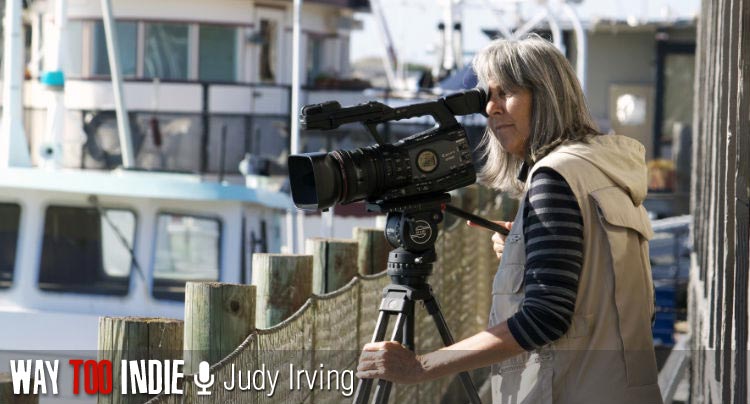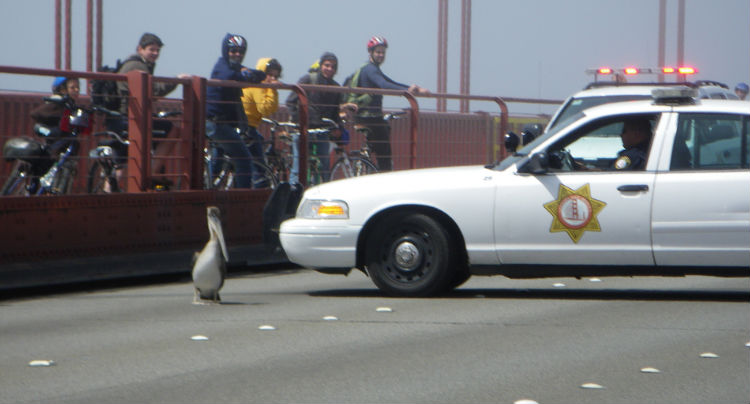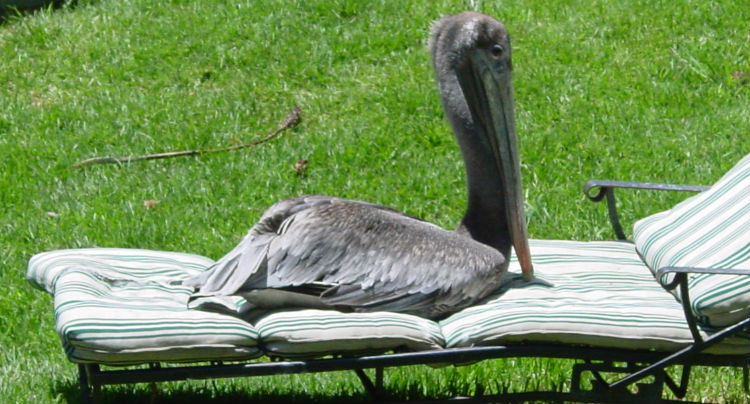Judy Irving On Nature Filmmaking: It Forces Me to Focus On Who We Share the Planet With

Bay Area filmmaker Judy Irving has had a fascination with Pelicans for about as long as she can remember. “I really loved what they looked like, that dinosaur look,” she told us as we caught up with her in her hometown of San Francisco. After years of loving the large, long-beaked birds, and after making a documentary about parrots (The Wild Parrots of Telegraph Hill) she felt it was time to give her favorite flying friends a movie of their own.
The result is Pelican Dreams, a documentary anchored by two birds in particular, Morro, a bird whose injuries have hindered his ability to fly, and Gigi, a similarly crippled pelican who landed on the Golden Gate Bridge and caused a traffic jam that would be the catalyst for Judy’s film. In our interview we talk about how Judy found Gigi; why she loves pelicans so much; the first time she touched a pelican; fakery in nature filmmaking; the hard reality of pelican euthanasia, and more.
Pelican Dreams opens this Friday in the Bay Area.

I almost never drive across the Golden Gate, but I did a few days ago and then saw your movie a couple days later. Were you there when Gigi was?
Judy: I wasn’t! But a friend of mine was in the traffic jam. She said, “You’ll never guess why I was held up in traffic!” We immediately started calling the Golden Gate people and the wildlife rescue people to find out where this bird had been taken. My husband Mark looked around on the internet and found the Youtube video. We got permission to use it from the bicyclists who shot it, and it became the opening credits sequence to the movie. I did follow that bird into care and named her Gigi after the Golden Gate.
Were you in search of a story to make a film at the time?
Judy: I was looking. I knew that I wanted to make a movie about pelicans because they’ve been my favorite bird since I was a kid, but I didn’t know where to begin. I didn’t want to make a standard nature documentary–I wanted to tell a story and get to know pelicans, if possible. I was waiting for what the universe would provide.
Gigi on the Golden Gate is a great visual and a great entry point for the film.
Judy: I got really excited. I was sorry for Gigi because she was hungry and disoriented and had to land on the roadway because she couldn’t fly anymore. But she was resilient and all she needed was some fish. It’s an iconic beginning for a film that takes place largely in the Bay Area. One of the first shots in the parrot movie is a foggy shot of the Golden Gate Bridge. This film opens with the bridge, so I kind of felt blessed.
There’s something really fascinating about the way pelicans are built, which you touch on in the movie. It’s like their bodies just fold in on themselves elegantly when they sleep.
Judy: I first saw pelicans when I was about five. My grandpa was a birder, and he had a spotting scope. He held me up to it and I saw all kinds of great birds out on Long Island and also in Florida. I really loved what they looked like, that dinosaur look. Also, I loved how graceful they were in the air and how awkward and clumsy they were when they landed. They’re big birds and they’re calm. I found out during filming that they’re not aggressive either with each other or people.
What was it like interacting with a pelican for the first time?
Judy: I actually hadn’t hung out with them until I made this movie. One of the goals was to try to get to know a pelican, but I didn’t actually get to touch a pelican during the making of this movie, if you can believe it. However, in the ’90s I was in Australia at this beach called Monkey Maya. It was famous for dolphins that would swim in and allow people to pet them. My friend and I went there, and big, beautiful white Australian pelicans were hanging around the beach to get the fish the dolphins didn’t. One of them was sitting on a rock wall, and I sat down next to it and was able to pet it on the head. I hate to admit it, but I did it! [laughs] The bird didn’t mind, and it was so soft and cottony. The pouch was warm and felt like your grandmother’s old, wrinkly skin. [laughs]
Do pelicans have the capacity to develop an affection for an individual person?
Judy: I don’t know if you would call it affection, but certainly recognition and interest. At Bill’s yard, Morro is very aware of Bill and where he is all day long, because he feeds Morro. If Bill is late with the sardines, Morro will grab his pant leg with his beak. I think Morro is very comfortable around Bill and expects to be fed, but who knows what the level of affection is.

I won’t spoil anything, but there’s fantastic footage in the film of Morro walking into a place he’s very unfamiliar with. I could watch that all day.
Judy: Me too. It was a half hour of footage, but I cut it down to 2 minutes. Morro was very tentative. It was very cool to see him gradually develop more confidence and overcome his fear in a new situation. I feel like I really learned a lot about him and pelicans in general by watching him explore that face.
You can’t write that stuff. As a documentarian, you kind of live for stuff like that, right?
Judy: Yes, you do! Nothing in the movie is set up or digitally enhanced or faked. There’s a lot of fakery in nature movies.
Interesting. Give me an example.
Judy: I heard about this BBC show they did on monarch butterflies where the crew came to California during the wrong time of year. They basically faked the migration by literally capturing a bunch of monarchs, gluing them to strings you couldn’t see, gluing their feet, and tying them to a truck so that their wings moved as they drove. This is hearsay, but I wouldn’t put it past them. There’s a ton of fakery in wildlife filmmaking. The stuff you see on television you really have to take with a grain of salt. A lot of it is faked, or the violence and aggression is emphasized over what their lives are actually like.
Pelican’s spend an awful lot of time just sitting around, as do many other animals. Now, you can’t make a movie where the creature just sits around unless you were Andy Warhol. That would be an accurate depiction of a pelican’s life, just sitting around and preening and occasionally flying around. When you’re out there with them, you have to slow down too. That’s what I love about nature photography.
It kind of forces you to take a breath.
Judy: Yes. You get away from all the gadgets and electronic connectivity. You’re out there in the real world we live in, but don’t pay much attention to, including me. I’m a city girl. That’s why I love going out there. It forces me to focus on what’s actually out there and who we share the planet with.
One of the more challenging parts of the film is when you talk about how pelicans who aren’t able to be rehabilitated must be subjected to euthanasia.
Judy: It was a shock to me. When I ask that question to Monty, the wildlife rehabilitator who takes care of Gigi in the movie, he said, “We don’t really like to keep them captive”. For pelicans, there’s no place for them to go. Zoos don’t want them. I asked what the alternative was, and he said euthanasia. That’s the first time I thought about this issue, and that’s how ignorant I was about this wildlife world when I started the movie.
I know the rehabilitators take steps to not treat the pelicans as pets, numbering them instead of naming them. But they’ve got to have some regret or sadness when they have to resort to euthanasia.
Judy: If they can’t help them, it’s always a disappointment. Sometimes the wing is broken in a way that it’ll never heal. The bird has to be euthanized. Sometimes with pelicans one of the most common problems is that they get monofilament fishing line wrapped around their leg or foot, and it cuts off the circulation below where it’s wrapped. When the foot has to be taken off, the bird of course can’t walk, so they generally cut to the chase and euthanize those birds. That’s because of someone leaving fishing line on a pier or throwing it in the water instead of cleaning it up and putting it away.
You talk about fisherman throwing full skeletons of big fish into the water.
Judy: When fisherman filet fish on the table, a lot of them throw the rest of the fish into the water, but if they only knew that pelicans try to eat those skeletons…They have spiny bones that don’t go down well, and the fish heads are way bigger than what they normally eat. That’s another problem that’s easily solved if fisherman knew this and actually followed up on it.
